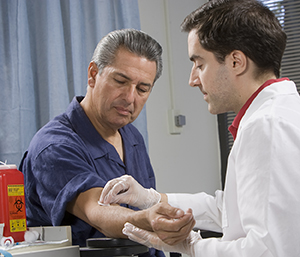Diagnosing Hepatitis C
Diagnosing Hepatitis C
To find out whether you are infected with the hepatitis C virus, your healthcare provider will ask questions about your health. He or she may also try to figure out how long you have been infected with hepatitis C. This may involve questions that seem personal. It’s important to answer honestly. You should also mention any symptoms that concern you. To test for hepatitis C, your blood is taken. A physical exam and certain tests help check for liver damage.
To test for hepatitis C, blood is taken and sent to a lab. It may take a few weeks to get your test results.
Getting tested
The CDC recommends that all people born between 1945 and 1965 get tested for hepatitis C. Blood tests look for substances in your blood that are linked to hepatitis C. These include:
ALT. This is a liver enzyme. Blood may have more ALT if the liver has been damaged.
Anti-HCV. The body tries to fight hepatitis C by making an antibody called anti-HCV. This substance is found in the blood and indicates exposure to hepatitis C.
Genotype. There are 6 hepatitis C genotypes. A blood test can reveal which genotype you have. This will affect the type of treatment.
HCV RNA. Some tests can show pieces of hepatitis C in infected blood and confirm that you are currently infected.
Looking for liver damage
During an exam, your healthcare provider may feel your abdomen to see if your liver is swollen or painful. Tests may also be done to check your liver for damage. These tests include:
CT scan. This is a type of specialized X-ray that shows a detailed picture of the liver by producing cross-sectional images.
Fibrosis panel. This blood test can help determine how severe the liver disease is.
Liver biopsy. During biopsy, a needle is used to take a small sample of tissue from the liver. The sample is then viewed under a microscope to look for inflammation and the amount of scar tissue.
MRI scan. This is a scan where strong magnetic fields and radio waves make images of the liver and blood vessels without the use of X-rays.
Ultrasound. This test uses painless sound waves to create a picture of the liver. It can roughly stage your liver disease. Your spleen size and portal vein size should be measured with each exam. The exam should take at least 20 minutes to make sure you have the correct number of images of the liver.
Checking for other infections
Hepatitis C infection can be more dangerous if you are also infected with certain other viruses. Your healthcare provider may test you for HIV and other types of hepatitis, such as types A and B. If you have not had hepatitis A or B, you may be given vaccines to protect you from getting them in the future.
Updated:
March 21, 2017
Sources:
Up To Date. Magnetic Resonance Imaging of the Hepatobiliary Tract
Reviewed By:
Lehrer, Jenifer, MD,Sather, Rita, RN
